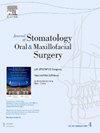Exploring the genetic expression of Sdf1, Foxc1 and histologic changes following mandibular advancement and recovery phase in Wistar rats
IF 1.8
3区 医学
Q2 DENTISTRY, ORAL SURGERY & MEDICINE
Journal of Stomatology Oral and Maxillofacial Surgery
Pub Date : 2024-10-05
DOI:10.1016/j.jormas.2024.102109
引用次数: 0
Abstract
Purpose
This study evaluated the impact of mandibular advancement on Sdf1 and Foxc1 gene expression in the mandibular condylar cartilage of young Wistar rats. By examining the changes that occur during a unique one-month recovery period, it highlights the critical role of gene expression and condylar adaptation during the recovery phase. The analysis focused on whether, during the recovery period, reversal changes occur when functional appliances are removed and whether genetic expression important for condyle growth and adaptation downregulates.
Material and methods
The study involved 30 male Wistar rats divided into 2 control groups Appliance Control and Recovery Control groups, and 2 experimental groups, the Appliance group with mandibular advancement bite-jumping appliance for 30 days, and the Recovery group with appliance for 30 days followed by a 30-day recovery. Molecular analysis of condylar cartilage using real-time RT-PCR and histological assessments was conducted.
Results
Significant genetic expression alterations were noted in both the experimental groups for Sdf1 (p < 0.05) and Foxc1 (p < 0.05). According to histological investigations, significant alterations with an increase in the proliferative and hypertrophic layer in condylar cartilage were seen.
Conclusion
Mandibular advancement bite-jumping appliances induce proliferative and hypertrophic layer changes in mandibular condylar cartilage, shown by elevated Foxc1 levels and decreased Sdf1 levels. Post-appliance removal, persistent gene expression reveals a true joint stimulation.

探索 Sdf1、Foxc1 的遗传表达以及 Wistar 大鼠下颌前突和恢复期的组织学变化。
目的:本研究评估了下颌前突对幼年 Wistar 大鼠下颌髁状突软骨中 Sdf1 和 Foxc1 基因表达的影响。通过研究为期一个月的独特恢复期所发生的变化,该研究强调了基因表达和髁突适应在恢复阶段的关键作用。分析的重点是,在恢复期,当功能性用具被移除时是否会发生逆转变化,以及对髁突生长和适应有重要影响的基因表达是否会下调:研究涉及 30 只雄性 Wistar 大鼠,分为 2 个对照组,即矫治器对照组和恢复对照组,以及 2 个实验组,即矫治器组,使用下颌前突咬合器 30 天;恢复组,使用矫治器 30 天,然后恢复 30 天。使用实时 RT-PCR 对髁状突软骨进行分子分析,并进行组织学评估:结果:在两个实验组中,Sdf1(p < 0.05)和 Foxc1(p < 0.05)的基因表达都发生了显著变化。组织学检查显示,髁突软骨的增生层和肥厚层明显增加:结论:下颌前突咬合器可引起下颌髁状突软骨增生和肥厚层的变化,表现为 Foxc1 水平升高和 Sdf1 水平降低。矫治器移除后,持续的基因表达显示出真正的关节刺激。
本文章由计算机程序翻译,如有差异,请以英文原文为准。
求助全文
约1分钟内获得全文
求助全文
来源期刊

Journal of Stomatology Oral and Maxillofacial Surgery
Surgery, Dentistry, Oral Surgery and Medicine, Otorhinolaryngology and Facial Plastic Surgery
CiteScore
2.30
自引率
9.10%
发文量
0
审稿时长
23 days
 求助内容:
求助内容: 应助结果提醒方式:
应助结果提醒方式:


